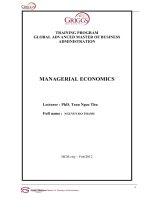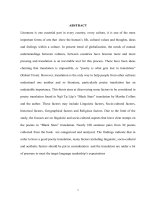02 pl 30 ban dich tieng anh
Bạn đang xem bản rút gọn của tài liệu. Xem và tải ngay bản đầy đủ của tài liệu tại đây (29.69 KB, 1 trang )
ONLINE Ph.D. DISSERTATION INFORMATION
The Ph.D. Dissertation title: “Clinical application of intravascular ultrasound in
coronary artery disease diagnosis and interventions”
Specialty: Internal medicine-Cardiology.
Code: 62.72.20.15
The Ph.D. candidate: Hoang Van Sy
Supervisor: Associate Professor Vo Thanh Nhan
Educational institution: The University of Medicine and Pharmacy at Ho Chi Minh City
SUMMARY OF NEW FINDINGS:
This intravascular ultrasound study (IVUS) enrolled 215 patients with 261 angiographic
intermediate coronary artery stenosis, the results showed that:
1. Intravascular ultrasound detected calcified lesions more than coronary angiography,
34.5% vs 8,4%, respectively, with p <0.05. Soft plaque was the highest proportion,
35.2% of atherosclerotic lesions.
2. With IVUS guidance, the optimal stent sizing was selected for coronary lesions
treatment. The mesurement of lesion length was longer in the IVUS group than in the
angiographic group: 32.57 ± 18.38 mm vs 15.84 ± 7.59 mm, p <0.001. Reference
coronary artery diameter measured by IVUS larger by coronary angiography: 3.99 ±
0.71 mm vs 2.82 ± 0.49 mm, p <0.001.
3. Coronary arterial remodeling was evaluated by using intravascular ultrasound
imaging, in vivo. Soft plaque and acute coronary syndrome were observed more
frequently in positive remodeling than in negative remodeling, 51,0% vs 25,8%; p <
0,001 and 47,7% vs 8,7%, p < 0,001, respectively. There was statistical difference of
plaque area and plaque burden in positive remodeling vs negative remodeling. Percent
diameter and area stenosis in positive remodeling was less than negative remodeling,
though minimal lumen area was similar in both groups.
4. By directly measuring the minimal lumen area, IVUS changed the selection on
treating coronary artery disease in some cases: 49.43% of the intermediate stenotic
lesions was really significant stenosis on IVUS.
5. Assessment of post stent intervention: proportion of complete stent apposition was
59,82%; optimal stent expantion was 66,96%; and symmetric stent expansion was
81,25%. The proportion of optimal stent result was not high: only 37,50% of deployed
stent. This result only related to the soft plaque morphology in our study. With IVUS
guided intervention, post dilation after deployment stent improved the proportion of
optimal stent result: 100% of complete stent apposition; 90,18% of optimal stent
expantion; and 98,21% of symmetric stent expansion.
Ho Chi Minh city, February 06th, 2014
SUPERVISOR
Ph.D. CANDIDATE
Associate Professor Vo Thanh Nhan
Dr. Hoang Van Sy
RECTOR









